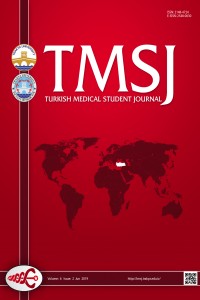Öz
Kaynakça
- 1. Conforti A, Morini F, Bagolan P. Difficult esophageal atresia: trick and treat. Semin Pediatr Surg 2014;23(5):261–9.
- 2. Smith N. Oesophageal atresia and tracheo-oesophageal fistula. Early Hum Dev 2014;90(12):947–50.
- 3. Sfeir R, Michaud L, Sharma D et al. National esophageal atresia register. Eur J Pediatr Surg 2015;25(6):497–9.
- 4. Gross RE. The surgery of infancy and childhood. 1st ed. Philadelphia: WB Saunders; 1953.
- 5. Macchini F, Parente G, Morandi A et al. Classification of esophageal strictures following esophageal atresia repair. Eur J Pediatr Surg 2018;28(3):243-9.
- 6. Larsen WJ. Embryonic folding. In: Larsen JW, ed. Essentials of Human Embryology. New York, NY: Churchill Livingstone; 1998:143–4.
- 7. Connor MJ, Springford LR, Kapetanakis VV et al. Esophageal atresia and transitional care-step 1: a systematic review and meta-analysis of the literature to define the prevalence of chronic long-term problems. Am J Surg 2015;209(4):747–59.
- 8. Sistonen SJ, Koivusalo A, Nieminen U et al. Esophageal morbidity and function in adults with repaired esophageal atresia with tracheoesophageal fistula a population-based long-term follow-up. Ann Surg 2010;25:1167–73.
- 9. Scheeren B, Maciel AC, Barros SG. Videofluoroscopic swallowing study: esophageal alterations in patients with dysphagia. Arquivos de Gastroenterologia 2014;51:221-5.
- 10. Kawahara H, Kubota A, Hasegawa T et al. Lack of distal esophageal contractions is a key determinant of gastroesophageal reflux disease after repair of esophageal atresia. J Pediatr Surg 2007;42:2017- 21.
- 11. Menzies J, Hughes J, Leach S et al. Prevalence of malnutrition and feeding difficulties in children with esophageal atresia. J Pediatr Gastroenterol Nutr 2017;64(4):100–5.
- 12. Rosen R, Hart K, Warlaumont M. Incidence of gastroesophageal reflux during transpyloric feeds. J Pediatr Gastroenterol Nutr 2011;52(5):532–5.
- 13. Rosen R, Levine P, Lewis J et al. Reflux events detected by pHMII do not determine fundoplication outcome. J Pediatr Gastroenterol Nutr 2010;50(3):251–5.
- 14. Morrow T. Wilson-cook’s flourish device uses magnets to fix pediatric esophageal atresia. Manag Care 2017;26(9):32-3.
Öz
Aims: Esophageal atresia is the most common congenital malformation of the esophagus. It can be diagnosed in the prenatal
period, during the delivery or at the neonatal intensive care unit. With the operation, the respiratory system and digestive tract
are being corrected to the anatomic position. In this case, we wanted to emphasize that patients with esophageal atresia may
continue to have functional problems even after successful surgical treatment. Case Report: After preterm delivery, a female
patient was consulted to Trakya University Department of Pediatric Surgery, at one day of age with the symptom of regurgitation
of saliva. There were no abnormalities on physical examination. Due to the inability to pass an orogastric tube to the stomach,
esophageal atresia was suspected. Thus, radiocontrast x-ray study was performed: the proximal esophageal pouch was identified,
and malformation was diagnosed. After the diagnosis, tracheoesophageal fistula has been ligated. The patient received physical
therapy after the operation, and she was followed-up for 10 months. A full recovery was observed, and the patient was able to
swallow food. Conclusion: Esophageal atresia with distal tracheoesophageal fistula is not an uncommon malformation. The
patients can have problems with swallowing in their infancy even they are treated surgically in the neonatal period.
Keywords: Esophageal atresia, tracheoesophageal fistula, newborn
Anahtar Kelimeler
Kaynakça
- 1. Conforti A, Morini F, Bagolan P. Difficult esophageal atresia: trick and treat. Semin Pediatr Surg 2014;23(5):261–9.
- 2. Smith N. Oesophageal atresia and tracheo-oesophageal fistula. Early Hum Dev 2014;90(12):947–50.
- 3. Sfeir R, Michaud L, Sharma D et al. National esophageal atresia register. Eur J Pediatr Surg 2015;25(6):497–9.
- 4. Gross RE. The surgery of infancy and childhood. 1st ed. Philadelphia: WB Saunders; 1953.
- 5. Macchini F, Parente G, Morandi A et al. Classification of esophageal strictures following esophageal atresia repair. Eur J Pediatr Surg 2018;28(3):243-9.
- 6. Larsen WJ. Embryonic folding. In: Larsen JW, ed. Essentials of Human Embryology. New York, NY: Churchill Livingstone; 1998:143–4.
- 7. Connor MJ, Springford LR, Kapetanakis VV et al. Esophageal atresia and transitional care-step 1: a systematic review and meta-analysis of the literature to define the prevalence of chronic long-term problems. Am J Surg 2015;209(4):747–59.
- 8. Sistonen SJ, Koivusalo A, Nieminen U et al. Esophageal morbidity and function in adults with repaired esophageal atresia with tracheoesophageal fistula a population-based long-term follow-up. Ann Surg 2010;25:1167–73.
- 9. Scheeren B, Maciel AC, Barros SG. Videofluoroscopic swallowing study: esophageal alterations in patients with dysphagia. Arquivos de Gastroenterologia 2014;51:221-5.
- 10. Kawahara H, Kubota A, Hasegawa T et al. Lack of distal esophageal contractions is a key determinant of gastroesophageal reflux disease after repair of esophageal atresia. J Pediatr Surg 2007;42:2017- 21.
- 11. Menzies J, Hughes J, Leach S et al. Prevalence of malnutrition and feeding difficulties in children with esophageal atresia. J Pediatr Gastroenterol Nutr 2017;64(4):100–5.
- 12. Rosen R, Hart K, Warlaumont M. Incidence of gastroesophageal reflux during transpyloric feeds. J Pediatr Gastroenterol Nutr 2011;52(5):532–5.
- 13. Rosen R, Levine P, Lewis J et al. Reflux events detected by pHMII do not determine fundoplication outcome. J Pediatr Gastroenterol Nutr 2010;50(3):251–5.
- 14. Morrow T. Wilson-cook’s flourish device uses magnets to fix pediatric esophageal atresia. Manag Care 2017;26(9):32-3.
Ayrıntılar
| Birincil Dil | İngilizce |
|---|---|
| Bölüm | Olgu Sunumu |
| Yazarlar | |
| Yayımlanma Tarihi | 1 Haziran 2019 |
| Gönderilme Tarihi | 1 Mayıs 2019 |
| Yayımlandığı Sayı | Yıl 2019 Cilt: 6 Sayı: 2 |

